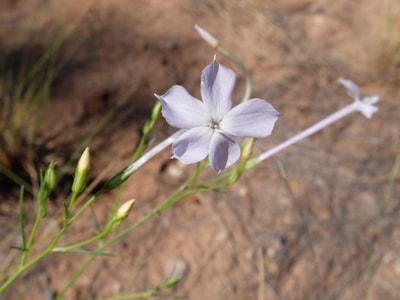|
Found in open, sandy areas
Seen blooming in September by Arroyo Trujillo This delicate plant can grow to 40 inches tall with many branches and slender grey-green leaves and stems. Flowers are white, light blue or lavender with a floral tube up to 3 inches long. It blooms from spring to fall depending on the rains, as so many plants do. Native Americans used the plant in quite a variety of ways. An infusion of the roots was used to eliminate the ozone in cases of lightning shock. A decoction of the leaves was taken for stomachache, crushed leaves and flowers were steeped into a tea that was taken for headaches, used on sores, for arthritis, as an eyewash, and served as a hair tonic to prevent baldness and lengthen the hair. The plant was chewed together with salt to treat heartburn. An infusion of the flowers was mixed with feed and given to sheep with stomach disorders. A cold infusion of the plant was applied daily to heal the incision in a castrated colt. The Zuni people used a poultice of the dried, powdered flowers to remove hair on newborns and children. Source. If you are trying to identify a different flower then you can check what other flowers bloom this month. If you cannot identify a flower from the website, send a photo and where you took it to [email protected]. Read online for tips.
0 Comments
Leave a Reply. |
AuthorI am Marilyn Phillips, a native of England, whose love of nature and the outdoors from childhood brought me by a circuitous route to Crested Butte, Colorado in 1993 and 16 years later to northern New Mexico. My exploration of the many trails in these areas, my interest in wildflowers and photography, and career in computer system design came together in this creation. If you have any corrections, comments or questions, please contact me by email. Archives
September 2025
Categoriescopyright © 2020
|



 RSS Feed
RSS Feed